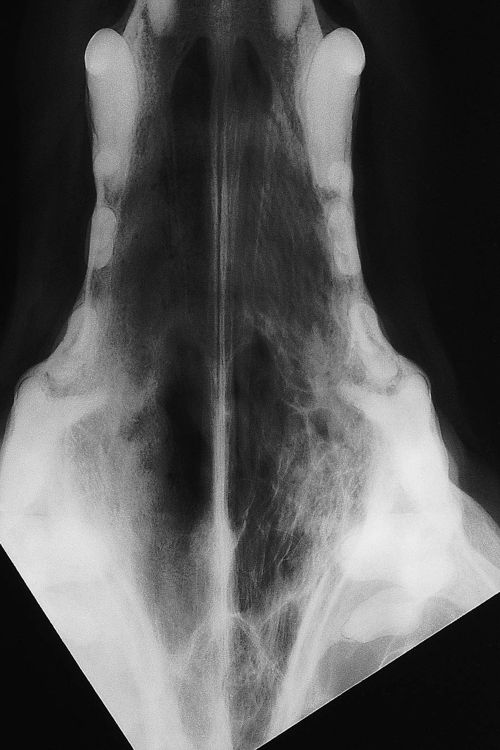Difference between revisions of "Small Animal Soft Tissue Surgery Q&A 11"
Ggaitskell (talk | contribs) |
|||
| Line 10: | Line 10: | ||
|q1=Based on this radiograph, what is the diagnosis and what signs enable you to be confident of your diagnosis? | |q1=Based on this radiograph, what is the diagnosis and what signs enable you to be confident of your diagnosis? | ||
|a1= | |a1= | ||
| − | Mycotic rhinitis due to Aspergillus spp. (A. fumigatus is the most common isolate) or Penicillium spp. is typical of the pattern present on radiographs. | + | Mycotic rhinitis due to ''Aspergillus'' spp. (''A. fumigatus'' is the most common isolate) or ''Penicillium'' spp. is typical of the pattern present on radiographs. |
There is marked turbinate destruction and an overall radiolucency of the left nasal chamber. | There is marked turbinate destruction and an overall radiolucency of the left nasal chamber. | ||
Other diagnostic considerations include intranasal foreign body (although increased opacity is commonly seen around the object) and neoplasia (aggressive destruction of turbinates, vomer bone and/or facial bones is seen, but usually with a homogeneous increase in opacity of the nasal passages). | Other diagnostic considerations include intranasal foreign body (although increased opacity is commonly seen around the object) and neoplasia (aggressive destruction of turbinates, vomer bone and/or facial bones is seen, but usually with a homogeneous increase in opacity of the nasal passages). | ||
| − | |l1= | + | |l1=Aspergillosis |
|q2=What other diagnostic tests would be useful to perform? | |q2=What other diagnostic tests would be useful to perform? | ||
|a2= | |a2= | ||
Rhinoscopy may reveal white, yellow or green fungal plaques on the nasal mucosa; concurrent biopsy samples are taken for histologic analysis, culture and cytologic examination. | Rhinoscopy may reveal white, yellow or green fungal plaques on the nasal mucosa; concurrent biopsy samples are taken for histologic analysis, culture and cytologic examination. | ||
| − | Serologic testing is performed (AGID or ELISA) but cross-reactivity between Aspergillus spp. and Penicillium spp. may make them hard to differentiate by this method. | + | Serologic testing is performed (AGID or ELISA) but cross-reactivity between ''Aspergillus'' spp. and ''Penicillium'' spp. may make them hard to differentiate by this method. |
| − | |l2= | + | |l2=Aspergillosis#Diagnosis |
|q3=Describe the most non-invasive treatment for this condition. Why does this therapy provide a better prognosis, and what complications can occur? | |q3=Describe the most non-invasive treatment for this condition. Why does this therapy provide a better prognosis, and what complications can occur? | ||
|a3= | |a3= | ||
| Line 31: | Line 31: | ||
Complications of this procedure include recurrence from incomplete distribution of the antifungal agent (although less likely to occur than with the surgical technique), and aspiration pneumonia or esophagitis from leakage of the agent if occlusion of the nasopharynx is not performed properly. | Complications of this procedure include recurrence from incomplete distribution of the antifungal agent (although less likely to occur than with the surgical technique), and aspiration pneumonia or esophagitis from leakage of the agent if occlusion of the nasopharynx is not performed properly. | ||
| − | |l3= | + | |l3=Aspergillosis#Treatment |
</FlashCard> | </FlashCard> | ||
Revision as of 15:56, 18 October 2011
This is a skull radiograph of a five-year-old, male German Shepherd Dog that presented for chronic sanguinopurulent nasal discharge, ulceration of the external nares and intermittent epistaxis.
| Question | Answer | Article | |
| Based on this radiograph, what is the diagnosis and what signs enable you to be confident of your diagnosis? | Mycotic rhinitis due to Aspergillus spp. (A. fumigatus is the most common isolate) or Penicillium spp. is typical of the pattern present on radiographs. There is marked turbinate destruction and an overall radiolucency of the left nasal chamber. Other diagnostic considerations include intranasal foreign body (although increased opacity is commonly seen around the object) and neoplasia (aggressive destruction of turbinates, vomer bone and/or facial bones is seen, but usually with a homogeneous increase in opacity of the nasal passages). |
Link to Article | |
| What other diagnostic tests would be useful to perform? | Rhinoscopy may reveal white, yellow or green fungal plaques on the nasal mucosa; concurrent biopsy samples are taken for histologic analysis, culture and cytologic examination. Serologic testing is performed (AGID or ELISA) but cross-reactivity between Aspergillus spp. and Penicillium spp. may make them hard to differentiate by this method. |
Link to Article | |
| Describe the most non-invasive treatment for this condition. Why does this therapy provide a better prognosis, and what complications can occur? | Treatment of nasal aspergillosis is by infusion of enilconazole or clotrimazole through an 8 French polypropylene catheter placed through the external nares midway along the dorsal nasal meatus on each side. The nares and nasopharynx are occluded using gauze sponges or laparotomy pads and the dog is placed in dorsal recumbency. After injection of the agent, the animal is placed in ventral recumbency and the nose tipped to allow drainage of excess fluid. Complications of this procedure include recurrence from incomplete distribution of the antifungal agent (although less likely to occur than with the surgical technique), and aspiration pneumonia or esophagitis from leakage of the agent if occlusion of the nasopharynx is not performed properly. |
Link to Article | |
